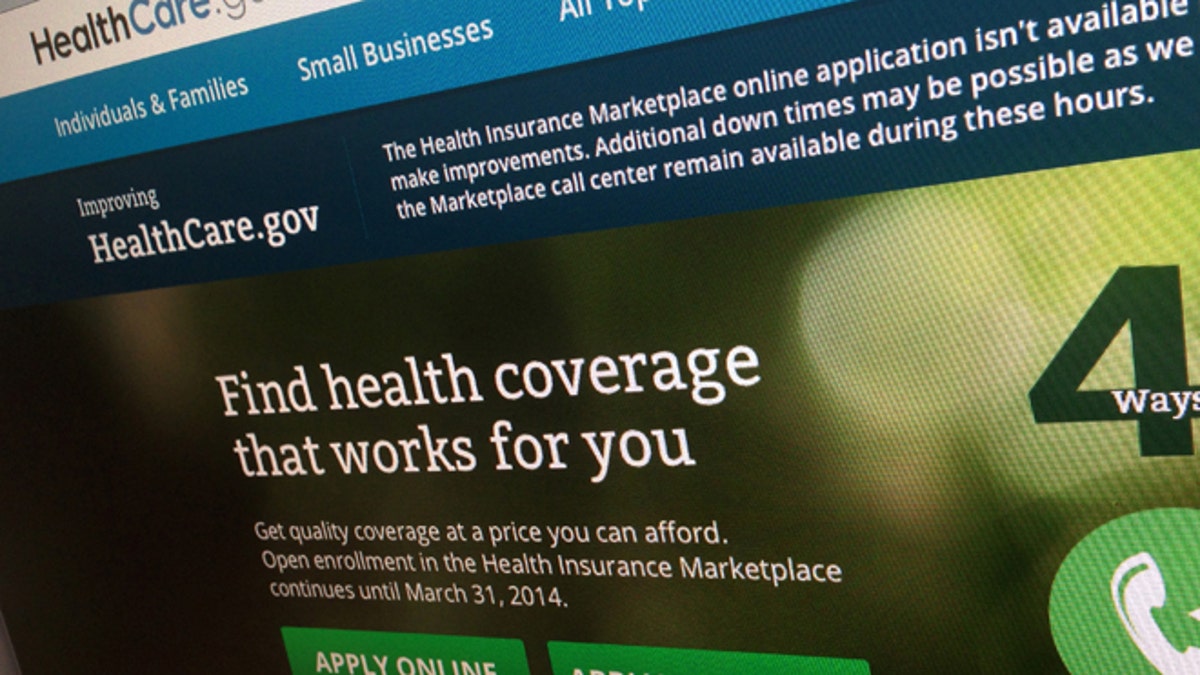
FILE: Nov. 29, 2013: The HealthCare.gov website is photographed in Washington, D.C. (AP)
The second round of ObamaCare signups begins Saturday with expectations for an improved shopper experience but also facing more challenges from Capitol Hill and in federal court.
President Obama and top administration officials have set a goal of enrolling 3 million Americans and to re-enroll the roughly 7 million people who enrolled in fall 2013.
There are 77 new health insurance providers participating for 2015, a sign they see a business opportunity.
Obama is urging consumers, whether they currently buy coverage through the insurance markets or still need to sign up for a plan, to go to the health care website and review their options. He says they could end up saving money or finding a better plan, And he's urging them to act fast since the enrollment period closes Feb. 15.
"This window won't stay open forever. You only have three months to shop for plans, so it's worth starting right away. And it might make a big difference for your family's bottom line," Obama said Saturday in his weekly radio and Internet address, which the White House released as the president visited Brisbane, Australia.
The first enrollment period began with a disastrous start -- the federal and some state-run ObamaCare websites crashing, failing to fully register some customers and giving out incorrect information.
The problems were fixed in several weeks, and federal officials have said in recent weeks the federal site is much improved and ready.
The federal website appeared to functioning Saturday.
Still, the Affordable Care Act is struggling to win hearts and minds.
The latest Associated Press-GfK poll finds that, if forced to choose between repealing the law and implementing it as written, 56 percent of Americans would repeal it completely. Only 41 percent would carry it out.
Meanwhile, fiscal conservative and Congress, particularly the GOP-controlled House, are recharging their attack on the law, with proposed hearings and investigations during the lame duck congressional session on such issues as premium increases and the impact of the law on the federal deficit.
And Colorado Sen.-elect Cory Gardner -- who upon taking office in January will also give Republicans control of the Senate -- said earlier this week that Congress should at least try to eliminate ObamaCare’s medical-device tax.
In addition, the Supreme Court has agreed to hear a legal challenge on the law's tax credits that make premiums affordable for millions.
However, Americans don’t see the law going away. In the recent survey, 61 percent of the respondents said they expect it to be implemented in its current form, or something near that.
Health and Human Services Secretary Sylvia M. Burwell, a management expert assigned to save what's been a problem child of social programs, says she's confident the sign-up season will be successful, even if it's only half as long as last year's.
Will the law remain on the books after Republicans gain full control of Congress in January?
"The idea of repeal ... is not something this administration will let happen," said Burwell.
What about the Supreme Court legal challenge?
"Nothing has changed," Burwell said, adding that the tax credits "will be continuing." At least for the time being. The Supreme Court isn't likely to hear the case until the spring, after 2015 open enrollment is over.
Website outages are not out of the question this year, but a full-scale meltdown seems less likely. HealthCare.gov has been revamped to handle last season's peak loads and beyond. The federal website will serve as the online portal for coverage in 37 states, while the remaining states run their own insurance exchanges. Consumers can also apply in person or through call centers.
The pool of potential customers is an estimated 23 million to 27 million people who don't have access to affordable coverage on the job.
For most newcomers, the online application has been simplified, cut to 16 computer screens from 76. Navigation is easier. Window shopping is available without first having to create an account.
Premiums for 2015 are a wild card. Nationally, the average increase is expected to be modest. But prices can vary dramatically from state to state, even within regions of a state. Many returning customers could end up facing premium increases if they don't shop around.
The administration is seeking to lower expectations. Burwell said her target is a total enrollment of 9.1 million people in 2015, a 28 percent increase. The nonpartisan Congressional Budget Office had estimated the number would nearly double, to 13 million people enrolled next year.
The administration is facing several new tests.
This sign-up period will be the first time that renewal has been tried for current customers, and also overlaps for the first time with tax-filing season.
For those already signed up, coverage will renew automatically if they do nothing, but that may not produce the best result. The returning customers could miss out on lower-premium options and get stuck with outdated and possibly incorrect subsidies. In most cases, they have until Dec. 15 to update their income information or switch insurance plans, in order to have the changes take effect on Jan. 1.
The tax issues will emerge during next year's filing season.
Current customers who got tax credits this year will have to file new tax forms to prove they got the right amount. Too much subsidy and their tax refunds will be reduced. Too little, and the government will pay them.
People who remained uninsured risk a penalty that will be deducted from their tax refunds. Millions may qualify for waivers, but getting exemptions could involve a paperwork ordeal.
Community-based counselors helping uninsured people say interest remains strong, but they worry about this year's abbreviated sign-up season.
Nathalie Milias, who works with Haitian groups in Miami, said she has been feeling the demand since the summer as uninsured people approached her.
"They see me in the store, they call," said Milias. "The locations I go to are already calling and saying, `How many appointments do you want for Monday?"'
The Associated Press contributed to this report.




